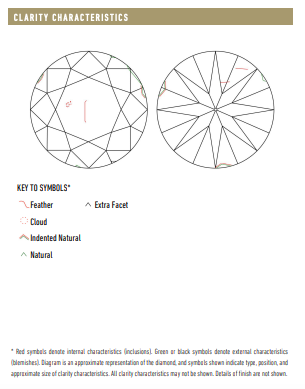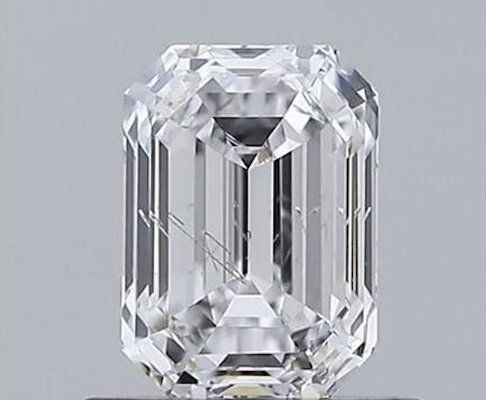What Does "Eye-Clean Diamond" Mean?

An eye-clean diamond is a diamond that does not have any visible inclusions (imperfections) to the naked eye. In other words, any flaws in the diamond cannot be seen unless you use a loupe.
How to Tell if a Diamond is Eye Clean
View a diamond from a minimum of 6 inches away from your face in a location with good lighting. If you cannot see any obvious flaws, like dark spots or specks of white, then it’s an eye-clean stone.
It can be difficult to tell while shopping online if your stone is eye clean. Keep in mind that if you are shopping online for a diamond, most sellers display extremely zoomed-in imagery and videos of their gems, so inclusions may not be as large or severe as they seem. At Ritani, our diamonds are zoomed in by 30%.
In general, you should avoid stones with inclusions at the center of the diamond’s table. A diamond’s table is its flat, topmost surface. It’s the stone’s largest facet. Here’s an example of a diamond with an inclusion at the center of its table:

This diamond was given a clarity grade of SI2 by the GIA. SI2 diamonds are the lowest clarity grade we offer at Ritani.
To make it easier for shoppers, we’ve developed an eye-clean feature on each diamond’s page that will let you know if your potential diamond is eye-clean or not.

When in doubt, connect with one of our non-commissioned gemologists who can give you a full analysis of your diamond.
What Clarity Grade is Eye-Clean?
In general, you should choose a diamond with a minimum clarity grade of VS2 or better to ensure that it is eye-clean. However, it is possible for stones with an SI1 or SI2 clarity grade to be eye-clean, but this isn’t always the case. You should always view HD images and videos of your diamond before making a purchase. Additionally, you should check your diamond’s certificate. Stones that are at least 1-carat or larger will plot where inclusions are in the stone, and what type of inclusions the stone has. Below is a GIA report that identifies a diamond’s inclusions.

By being aware of eye-clean stones, you can save thousands of dollars. It’s not necessary to choose a Flawless or Internally diamond if you can choose a diamond with VS2 clarity that is eye-clean and far less expensive. Flawless and Internally Flawless stones are very rare, giving them a much higher premium.
Be Cautious with These Diamond Cuts
It can be a little more difficult to find an eye-clean emerald-cut or Asscher-cut diamond. These diamonds are step-cut diamonds, meaning they have large, open facets that make inclusions more visible.

Above: an emerald-cut diamond with SI2 Clarity
These cuts don’t hide inclusions, as well as a brilliant-cut diamond, would. For an emerald-cut or Assher-cut, you may want to consider a stone with VS1/VS2 clarity or better. Always view HD imagery and videos of your diamond before purchasing it.
FREQUENTLY ASKED QUESTIONS
Are SI1 or SI2 Diamonds Eye Clean?
They can be but are not always. It’s a lot more likely for diamonds under 1-carat to appear eye-clean that have an SI1 or SI2 clarity grade – the larger the stone, the more obvious inclusions will be. Again, you should always view images and videos of your diamond to make sure it doesn’t have detectable flaws.
Are VS1 or VS2 Diamonds Eye Clean?
Diamonds with a VS1 or VS2 clarity grade will be eye-clean, but you should always view real images of the diamond just in case. Most of the diamonds on our site have HD imagery and videos, but in the off chance that they don’t, please contact us and we can provide imagery for you.
Are you ready to discover your dream diamond?



